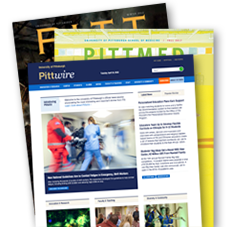Pitt Lecture Series Offers Snapshot on Choosing the Best From Pittsburgh's Extensive Photographic History
PITTSBURGH-Documenting Pittsburgh's history in photographs means getting behind the iconic panorama from Mt. Washington and looking closer at the innumerable portraits of the people who lived in its neighborhoods, the structures built and razed, and the industries that thrived and faltered. Four authors of illustrated works about Pittsburgh will discuss the trials and rewards of exploring Pittsburgh's visual past in Publishing Pittsburgh Pictures, a lecture series hosted by the University of Pittsburgh's School of Information Sciences (iSchool) and the student chapter of the Society of American Archivists. All lectures will begin at 11 a.m. in Room 501 of the Information Sciences Building, 135 N. Bellefield Ave. in Oakland. An informal 10:30 a.m. coffee session with the speaker will precede each event. Lecture dates and brief biographies of the speakers follow.
The speakers will discuss the challenges of locating suitable images, assembling text, and negotiating permissions and other intellectual property issues. They also will discuss identifying and working with a publisher. More information is available on the iSchool Web site at www.ischool.pitt.edu/pghpics/
Friday, Jan. 16
Linda Benedict-Jones, photography curator at the Carnegie Museum of Art, will discuss her work on creating the exhibition catalog for the museum's 1997 exhibition, "Pittsburgh Revealed: Photographs" Since 1850. The exhibition was the first to consider photography in Pittsburgh from the medium's beginnings to the present. It included hundreds of photographs, many never before exhibited, of Pittsburgh people, landscapes, industrial scenes, public events, disasters, and neighborhoods presented through personal snapshots, corporate documents, journalistic records, studio portraits, blueprints, and art. Benedict-Jones was appointed curator of the museum's new Department of Photography in 2008, where she will oversee a collection of about 4,500 photographs and plan exhibitions and acquisitions. Prior to joining the Carnegie, Benedict-Jones was the executive director of the Silver Eye Center for Photography in Pittsburgh's South Side.
Friday, Jan. 30
Ron Baraff and Tiffani Emig from the Rivers of Steel National Heritage Area in Homestead will talk about Rivers of Steel's "Seeing Pittsburgh" project. Rivers of Steel gave 44 Pittsburghers from 11 neighborhoods cameras to capture the daily sights and stories of their neighborhood in an attempt to define their communities. "Seeing Pittsburgh" depicts industrial and post-industrial neighborhoods, early "suburbs within the city," and white-collar and working-class suburbs, as seen by a diverse group of volunteer photographers. The results form the basis of the "Seeing Pittsburgh" exhibition on display through Jan. 31 at Rivers of Steel, 623 E. Eighth Ave., Homestead, and the exhibition's accompanying book. Exhibition curators Baraff and Emig will explore the project's evolution from an idea to a finished product, including building community partnerships, collecting oral histories, and making editorial decisions.
Wednesday, Feb. 25
Martin Aurand, architecture librarian at Carnegie Mellon University and archivist of the school's Architecture Archives, will speak about the writing and publication of his book, "The Spectator and the Topographical City" (University of Pittsburgh Press, 2006). His book explores Pittsburgh's buildings in relation to local topography and how the natural environment influenced architecture and resulted in a city with globally unique structural and environmental features. Aurand will discuss his inspiration and intention for the book, including conceptual and logistical issues related to working with a complex text and a large number of illustrations. At their best, illustrations reinforce and even generate textual arguments, yet they may also distract the reader. Aurand describes how an author and publisher balance text and illustrations so that the illustrations complement the text. Aurand is the author of scholarly reviews and articles and another book, "The Progressive Architecture of Frederick G. Scheibler, Jr". (University of Pittsburgh Press, 1994).
Wednesday, March 18
Miriam Meislik will discuss the process of compiling her book, "Historic Photos of Pittsburgh," (Turner Publishing, 2008), which traces of the city's development through the everyday activity in workplaces, homes, and streets. Meislik is archivist and photo curator for Pitt's Archives Service Center, part of the University Library System, and a lecturer in the iSchool's Archives, Preservation, and Records Management program. Meislik has been working in the archives profession for 16 years and specializes in archiving and preserving photographic, film, video, audio, and digital materials. Meislik is also active in the Society of American Archivists, where she was past chair of the Visual Materials Section and the Visual Materials Cataloging and Access Roundtable.
###
1/13/09/amm
Media Resources
Schools of the Health Sciences Media Relations
For more information about Pitt's schools of dental medicine, health and rehabilitation sciences, medicine, nursing, pharmacy, and public health, click here >
To locate stories from health science schools prior to 2013, visit the UPMC news archives »
Urgent Question?
University of Pittsburgh news reps are available to answer urgent media inquiries. Outside of regular business hours (Mon-Fri, 8:30 a.m.-5 p.m.), please email us at media@pitt.edu.
News reps for University of Pittsburgh Health Sciences schools can be reached outside of regular business hours through the paging operator at 1+412-647-2345.


